第八次课 情态动词
- 格式:docx
- 大小:18.46 KB
- 文档页数:4
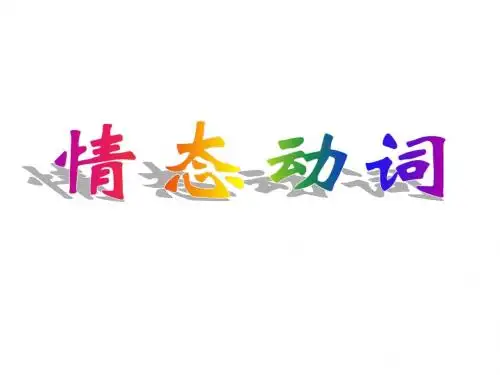
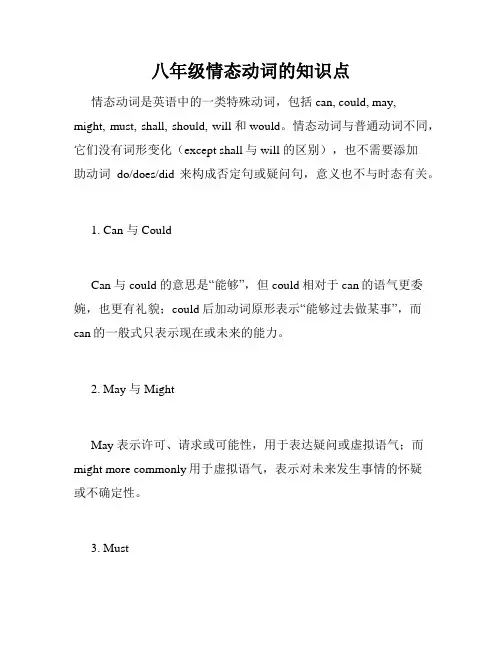
八年级情态动词的知识点情态动词是英语中的一类特殊动词,包括can, could, may, might, must, shall, should, will和would。
情态动词与普通动词不同,它们没有词形变化(except shall与will 的区别),也不需要添加助动词do/does/did来构成否定句或疑问句,意义也不与时态有关。
1. Can 与 CouldCan 与could 的意思是“能够”,但could相对于can的语气更委婉,也更有礼貌;could后加动词原形表示“能够过去做某事”,而can的一般式只表示现在或未来的能力。
2. May 与 MightMay 表示许可、请求或可能性,用于表达疑问或虚拟语气;而might more commonly用于虚拟语气,表示对未来发生事情的怀疑或不确定性。
3. MustMust强调必须、不可避免,表示绝对肯定或高度推断;用于表达命令或建议,以及对情况的强烈表示。
4. Shall 与 ShouldShall 和should用于表达命令、请求或建议,但shall主要用于将来时,而should则是一种情态动词,强调道义义务和道义要求,较具有礼貌和客观性。
5. Will 与 WouldWill 表示将要发生的事情,也表示愿望或决心;Would则常用于虚拟语气和条件句,表示假设、愿望或敬语。
6. Can与May的用法差异Can 表示某人能够做某事,能力在第一位。
而may则强调许可、允许的意义,是语气委婉的表达方式。
7. Should与Would的用法差异Should是一种道义上的情态动词,引申出一定的礼貌和可能性;而would则更多地表示愿望和推测,即假设的语气。
8. Must 和Have to两者不同点:must是限定词,have to 则比较口语化,常用于口语中;must表示主观推断,而have to则表示客观事实。
9. 动词原型与情态动词连用情态动词和动词原形连用是比较常见的用法。
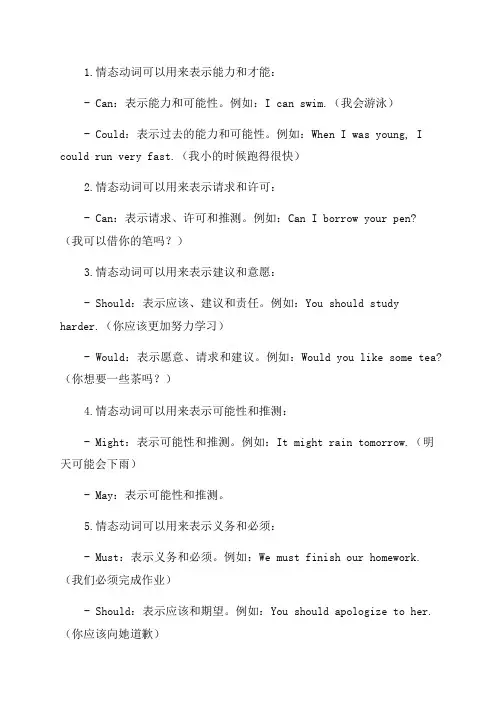
1.情态动词可以用来表示能力和才能:- Can:表示能力和可能性。
例如:I can swim.(我会游泳)- Could:表示过去的能力和可能性。
例如:When I was young, I could run very fast.(我小的时候跑得很快)2.情态动词可以用来表示请求和许可:- Can:表示请求、许可和推测。
例如:Can I borrow your pen?(我可以借你的笔吗?)3.情态动词可以用来表示建议和意愿:- Should:表示应该、建议和责任。
例如:You should study harder.(你应该更加努力学习)- Would:表示愿意、请求和建议。
例如:Would you like some tea?(你想要一些茶吗?)4.情态动词可以用来表示可能性和推测:- Might:表示可能性和推测。
例如:It might rain tomorrow.(明天可能会下雨)- May:表示可能性和推测。
5.情态动词可以用来表示义务和必须:- Must:表示义务和必须。
例如:We must finish our homework.(我们必须完成作业)- Should:表示应该和期望。
例如:You should apologize to her.(你应该向她道歉)总结起来,八年级英语中的情态动词有can, could, may, should, would, might和must,它们可以表示能力、请求、许可、建议、意愿、可能性、推测、义务和必须。
不同的情态动词在不同的语境下有不同的用法和含义,所以需要根据具体语境和意图进行准确使用。
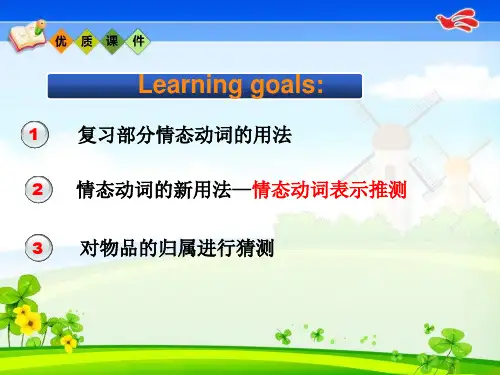
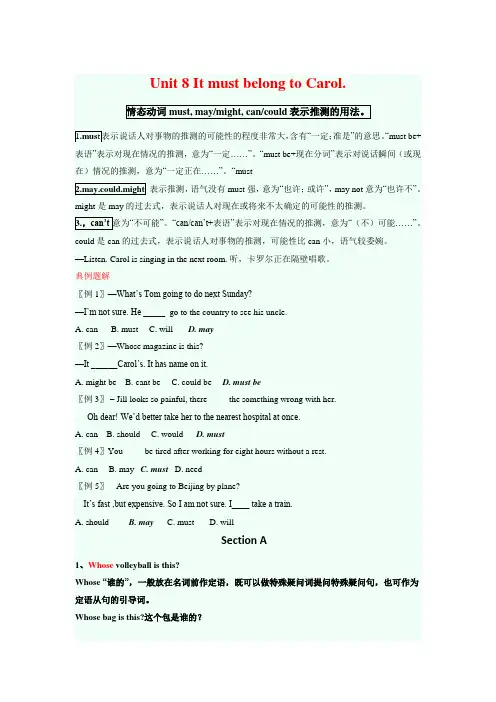
Unit 8 It must belong to Carol.情态动词must, may/might, can/could表示推测的用法。
1.mus t表示说话人对事物的推测的可能性的程度非常大,含有―一定;准是‖的意思。
―must be+表语‖表示对现在情况的推测,意为―一定……‖。
―must be+现在分词‖表示对说话瞬间(或现在)情况的推测,意为―一定正在……‖。
―must2.may.could.might表示推测,语气没有must强,意为―也许;或许‖,may not意为―也许不‖。
might是may的过去式,表示说话人对现在或将来不太确定的可能性的推测。
3.,can’t意为―不可能‖。
―can/can’t+表语‖表示对现在情况的推测,意为―(不)可能……‖。
could是can的过去式,表示说话人对事物的推测,可能性比can小,语气较委婉。
—Listen. Carol is singing in the next room. 听,卡罗尔正在隔壁唱歌。
典例题解〖例1〗—What’s Tom going to do next Sunday?—I’m not sure. He ______go to the country to see his uncle.A. canB. mustC. willD. may〖例2〗—Whose magazine is this?—It ______Carol’s. It has name on it.A. might beB. cant beC. could beD. must be〖例3〗– Jill looks so painful, there ____ the something wrong with her.-- Oh dear! We’d better take her to the nearest hospital at once.A. canB. shouldC. wouldD. must〖例4〗You ____ be tired after working for eight hours without a rest.A. canB. mayC. mustD. need〖例5〗---Are you going to Beijing by plane?---It’s fast ,but expensive. So I am not sure. I____ take a train.A. shouldB. mayC. mustD. willSection A1、Whose volleyball is this?Whose “谁的”,一般放在名词前作定语,既可以做特殊疑问词提问特殊疑问句,也可作为定语从句的引导词。
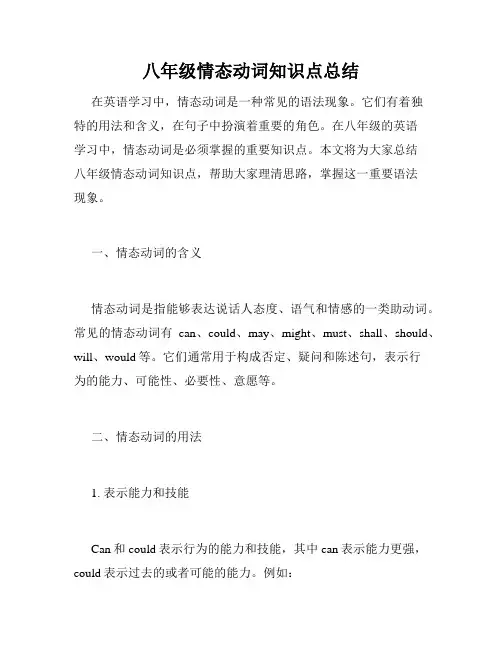
八年级情态动词知识点总结在英语学习中,情态动词是一种常见的语法现象。
它们有着独特的用法和含义,在句子中扮演着重要的角色。
在八年级的英语学习中,情态动词是必须掌握的重要知识点。
本文将为大家总结八年级情态动词知识点,帮助大家理清思路,掌握这一重要语法现象。
一、情态动词的含义情态动词是指能够表达说话人态度、语气和情感的一类助动词。
常见的情态动词有can、could、may、might、must、shall、should、will、would等。
它们通常用于构成否定、疑问和陈述句,表示行为的能力、可能性、必要性、意愿等。
二、情态动词的用法1. 表示能力和技能Can和could表示行为的能力和技能,其中can表示能力更强,could表示过去的或者可能的能力。
例如:He can swim very fast.(他游泳很快。
)She could play the piano when she was young.(她小时候会弹钢琴。
)2. 表示推测和可能性May、might和could用于表示可能性和推测,其中may表示可能性更大,could表示可能性更小。
例如:It may rain tomorrow.(明天可能下雨。
)He might be at home.(他可能在家里。
)3. 表示必要性和义务Must表示强制性的必要性,should表示建议性的必要性,其中must用于肯定句和疑问句,should用于陈述句中。
例如:You must wear a seatbelt while driving.(开车时你必须系上安全带。
)You should eat more vegetables.(你应该多吃蔬菜。
)4. 表示意愿和请求Will、would和can用于表示意愿和请求,其中will和would用于陈述句和状语从句中,can用于疑问句和请求。
例如:He will help me with my homework.(他会帮我完成作业。
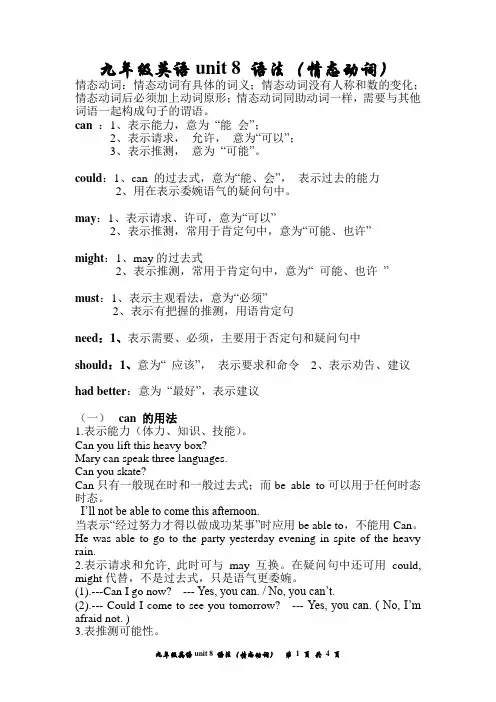
九年级英语unit 8 语法(情态动词)情态动词:情态动词有具体的词义;情态动词没有人称和数的变化;情态动词后必须加上动词原形;情态动词同助动词一样,需要与其他词语一起构成句子的谓语。
can:1、表示能力,意为“能会”;2、表示请求,允许,意为“可以”;3、表示推测,意为“可能”。
could:1、can 的过去式,意为“能、会”,表示过去的能力2、用在表示委婉语气的疑问句中。
may:1、表示请求、许可,意为“可以”2、表示推测,常用于肯定句中,意为“可能、也许”might:1、may的过去式2、表示推测,常用于肯定句中,意为“ 可能、也许”must:1、表示主观看法,意为“必须”2、表示有把握的推测,用语肯定句need:1、表示需要、必须,主要用于否定句和疑问句中should:1、意为“ 应该”,表示要求和命令2、表示劝告、建议had better:意为“最好”,表示建议(一)can 的用法1.表示能力(体力、知识、技能)。
Can you lift this heavy box?Mary can speak three languages.Can you skate?Can只有一般现在时和一般过去式;而be able to可以用于任何时态时态。
I’ll not be able to come this afternoon.当表示“经过努力才得以做成功某事”时应用be able to,不能用Can。
He was able to go to the party yesterday evening in spite of the heavy rain.2.表示请求和允许, 此时可与may互换。
在疑问句中还可用could, might代替,不是过去式,只是语气更委婉。
(1).---Can I go now? --- Yes, you can. / No, you can’t.(2).--- Could I come to see you tomorrow? --- Yes, you can. ( No, I’m afraid not. )3.表推测可能性。

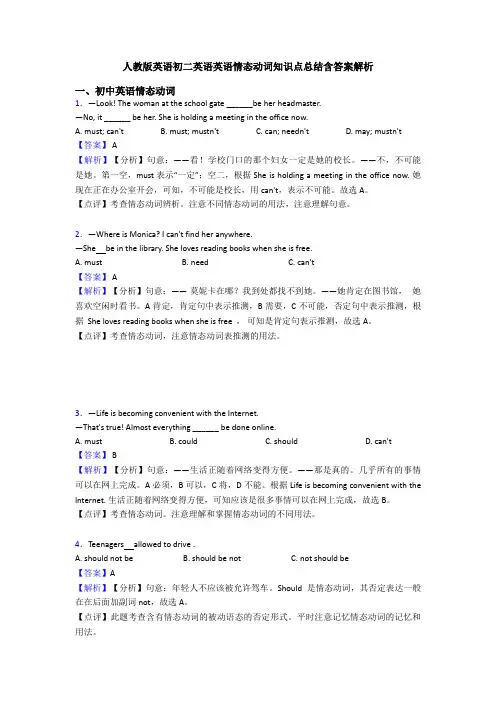
人教版英语初二英语英语情态动词知识点总结含答案解析一、初中英语情态动词1.—Look! The woman at the school gate ______be her headmaster.—No, it ______ be her. She is holding a meeting in the office now.A. must; can'tB. must; mustn'tC. can; needn'tD. may; mustn't【答案】 A【解析】【分析】句意:——看!学校门口的那个妇女一定是她的校长。
——不,不可能是她。
第一空,must表示“一定”;空二,根据She is holding a meeting in the office now. 她现在正在办公室开会,可知,不可能是校长,用can't,表示不可能。
故选A。
【点评】考查情态动词辨析。
注意不同情态动词的用法,注意理解句意。
2.—Where is Monica? I can't find her anywhere.—She be in the library. She loves reading books when she is free.A. mustB. needC. can't【答案】 A【解析】【分析】句意:——莫妮卡在哪?我到处都找不到她。
——她肯定在图书馆,她喜欢空闲时看书。
A肯定,肯定句中表示推测,B需要,C不可能,否定句中表示推测,根据 She loves reading books when she is free ,可知是肯定句表示推测,故选A。
【点评】考查情态动词,注意情态动词表推测的用法。
3.—Life is becoming convenient with the Internet.—That's true! Almost everything ______ be done online.A. mustB. couldC. shouldD. can't【答案】 B【解析】【分析】句意:——生活正随着网络变得方便。
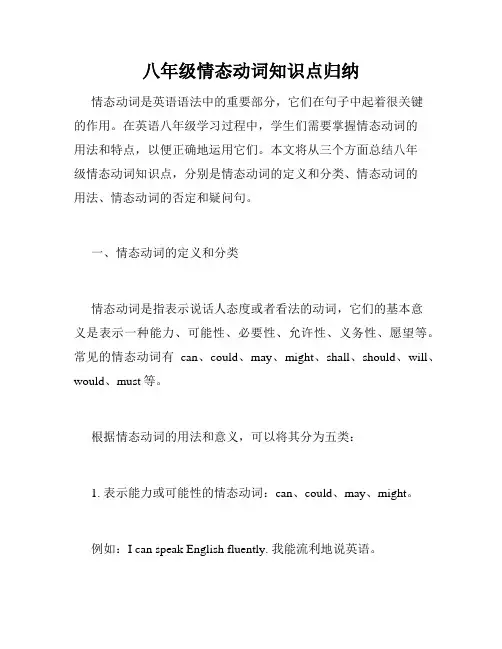
八年级情态动词知识点归纳情态动词是英语语法中的重要部分,它们在句子中起着很关键的作用。
在英语八年级学习过程中,学生们需要掌握情态动词的用法和特点,以便正确地运用它们。
本文将从三个方面总结八年级情态动词知识点,分别是情态动词的定义和分类、情态动词的用法、情态动词的否定和疑问句。
一、情态动词的定义和分类情态动词是指表示说话人态度或者看法的动词,它们的基本意义是表示一种能力、可能性、必要性、允许性、义务性、愿望等。
常见的情态动词有can、could、may、might、shall、should、will、would、must等。
根据情态动词的用法和意义,可以将其分为五类:1. 表示能力或可能性的情态动词:can、could、may、might。
例如:I can speak English fluently. 我能流利地说英语。
2. 表示建议或命令的情态动词:shall、should。
例如:You should go to bed early. 你应该早点睡觉。
3. 表示必要性或义务的情态动词:must、have to。
例如:You must finish your homework. 你必须完成你的作业。
4. 表示意愿或决心的情态动词:will、would。
例如:I will help you with your English. 我会帮你做英语。
5. 表示推测和猜测的情态动词:may、might、could。
例如:He may be late for the meeting. 他也许会迟到会议。
二、情态动词的用法情态动词的用法有以下几点:1. 情态动词后面要接动词原形。
例如:I can swim. 我会游泳。
2. 情态动词没有人称和数的变化。
例如:You can ride a bike. 你会骑自行车。
3. 情态动词不能单独作为谓语动词,必须与其他动词一起使用。
例如:She should study harder. 她应该更努力地学习。
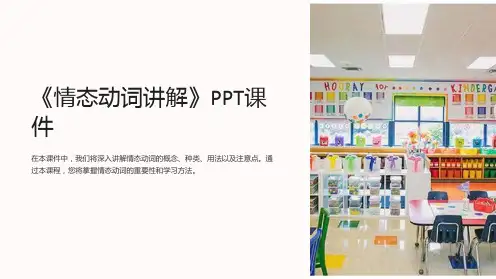
Unit 8 Moving inI. Vocabulary1.Permit sb. to do sth. 允许某人做某事The boss permits Susan to take a sick leave (病假) for three days.2.Put up sth 张贴某物The cinema puts up a poster of Spartan 300.II. Grammar 语法1.情态动词can:can表示“能够”的意思。
在英语中,情态动词用于描述个人意愿、态度或能力,故名“情态”动词。
需要注意的是,情态动词可跟任何人称搭配使用,其形式无须发生变化,情态动词后面连接的动词必须用原形。
(P. 86 Language Focus)基本结构:can + 动词原形A.肯定句You can use the phone in the living room.We can take a No. 161 bus to get to the airport.Bigenna (美源发彩) can make your hair black in five minutes, or it also can make it black gradually (逐渐地).他能在10分钟内吃下(eat)10个汉堡包(hamburger)。
He can eat 10 hamburgers in 10 minutes.I believe I can fly. I believe I can touch the sky.B.否定句:在can后面加上not,可缩写为can’t。
You can not/can’t smoke here. It is non-smoking area.I can not/can’t live without you by my side.I can not/can’t believe (相信) my eyes. You look a like fairy now!你不能对我这样做,我是那么地爱你。
情态动词(一)1.Could1) “can”的过去意义。
When he was young, he could swim across the river. (表能力)The dean said we could attend the meeting. (表许可)I told you the news couldn’t be true. (表可能)2)“现在”或“将来”意义,比用can礼貌,语气委婉。
you children could/can help me to move these stools.Could/Can you give me a lift?2.might1)“may” 的过去的意义。
I thought that it might rain. (表可能)You might leave when you liked. (表许可)2)“现在”意义,礼貌表达“征求许可”,“请求”,“建议”等。
Might I ask you whether you are using the typewriter?Might I use your dictionary a while?I wonder if I might leave now?3)“将来”意义,一种较小的可能性。
It might be hot tomorrow.3. mustmust 的过去式仍是must(通常用于间接引语):We were told we mustn’t smoke in there. (表禁止)I told my son that he must work well in the factory. (表必须)She said that he must be Tom. (表推测)4.ought to 和should这两个词表示:1)“应该”You ought to/should buy an English dictionary.The floor ought to /should be washed once a week.2) 推测Tom ought to /should be home now.The building ought to /should be visible from here.5. used to表示过去的习惯行为或过去的状况,现在已经不存在:The couple used to have a walk after supper.They used to live in the country.I used to be a worker.6. have tohave to 与must意义接近,所不同的是:1)must表主观,have to表客观:I am afraid I must go now. (表示主观上想走)I am afraid I have to go now. (表示客观因素要走)You must be back by 5 in the afternoon. (指说话者的权威性,说话者本人要”对方“一定”。
情态动词的基本用法教案一、教学目标1. 让学生掌握情态动词can, may, must, could, might, should 的基本用法。
2. 培养学生运用情态动词进行日常交流的能力。
3. 提高学生对英语语法和词汇的理解。
二、教学内容1. 情态动词can 的用法:表示能力、允许、请求、可能性等。
2. 情态动词may 的用法:表示请求、允许、可能性等。
3. 情态动词must 的用法:表示肯定、必须、推测等。
4. 情态动词could 的用法:表示过去的能力、请求、可能性等。
5. 情态动词might 的用法:表示可能性、请求、谦让等。
6. 情态动词should 的用法:表示应该、建议、可能性等。
三、教学重点与难点1. 重点:掌握情态动词can, may, must, could, might, should 的基本用法。
2. 难点:区分情态动词之间的用法和搭配,以及在不同语境中的运用。
四、教学方法1. 任务型教学法:通过小组讨论、角色扮演等任务,让学生在实际语境中运用情态动词。
2. 情境教学法:创设各种真实的情境,让学生在实践中学会使用情态动词。
3. 互动式教学法:引导学生积极参与课堂活动,提高课堂氛围,增强学生的学习兴趣。
五、教学步骤1. 导入:以一段对话引入情态动词的概念,激发学生的学习兴趣。
2. 讲解:分别讲解情态动词can, may, must, could, might, should 的基本用法。
3. 练习:设计不同情境的练习题,让学生运用所学情态动词进行回答。
4. 小组讨论:让学生分组讨论情态动词在不同情境下的用法,分享学习心得。
5. 角色扮演:分组进行角色扮演,模拟真实场景,运用情态动词进行交流。
6. 总结:对本节课所学内容进行总结,强调情态动词的用法和搭配。
7. 作业:布置相关练习题,巩固所学知识。
六、教学评估1. 课堂练习:观察学生在练习中的表现,了解他们对于情态动词用法的掌握情况。
八年级上册第8课知识点《八年级上册第8课知识点》第八课是《快乐的飞行》。
故事描述了一只鸽子和一只海鸥的冒险旅程,强调了自由和友谊的主题。
本篇文章将对该课的知识点进行探究。
一、课文结构及内容《快乐的飞行》的结构呈现清晰明了的叙事结构,一开始详细描述了鸽子和海鸥之间的友谊,随后进行了一次有关冒险的尝试,最后两只鸟通过协作成功地完成了任务。
二、语法知识点1、现在进行时在时间层面上,现在进行时指现在正在进行的动作。
如文中描述的“The big white birds are gliding around and around in the sky.”(大白鸟在空中盘旋)。
2、过去式过去式用于表达过去某一时刻或一段时间内的动作,如文中所写的“He caught up with the seagull and the two birds flew together over the city.”(他赶上了海鸥,两只鸟一起飞过城市)。
3、动词-ing 形式作主语动词-ing 形式可以用作句子的主语,它所表达的往往是某个动作或状态的持续性或延续性,如文中描述的“Flying is fun.”(飞行是有趣的)。
4、情态动词 can / could情态动词 can / could 表示能力和可能性,在文章中经常出现,例如“I can't fly as high or as fast as you can.”(我不能像你那样高或那么快地飞行)。
三、词语探究1、 glideglide 是指在空中悠闲地、轻松地飞行,如文中所述的“The big white birds are gliding around and around in the sky.”(大白鸟在空中盘旋)。
2、 tucktuck 是闭合、贴合的意思,在本文中指使翅膀向身体收拢。
如“The pigeon and the sea gull tuck their wings in and begin to fall.”(鸽子和海鸥收拢翅膀,开始下降)。
情态动词:情为何物之情态动词~
1,推测(对现在,未来的推测)
练习案例:
It ——be my mother. because someone is knocking at the door, and mom always go back home at this time(mom is not at home)
2,It——be my mother(mom is at home),someone is knocking at the door
黄金规律:can 无肯定may无疑问;Must只能用于肯定句,不能用于否定疑问句;
could全部都可以;must 70%;can/could;may/might 40%;may not/might not可能不20%;can’t/ could not 0%
需要注意的是might不是may的过去式,同理:could也不是can 的过去式
练习:
1,the cake is very sweet, you ——put a lot of sugar.
2,It——be very expensive, I never dream of buying it
3,It ——be correct.(做单选题并不完全确定这个前提)
4,She looks very happy,she——have passed the examination. A, should B,could C,must D might
5,Helen——go on the trip with us, but she isn’t very quiet sure A, should B,may C,must D can
3,定义:四个基本定义
1,Can:I can swim(表示能力);
2,Can the man be his father(表示可能)could是它的同义词;
3,Can I come in?(表示允许),could是can的委婉语气.
Could I come in?不认识的人表礼貌
4,May:表示可能(might,can,could);表示允许的语气(may,might)
Can I come in? could I come in? may I come in? might I come in? (越来越委婉) 回答全部用can回答
Must: it must be his mother(表示一定);
must you leave now?(表示必须,与have to同义词)
4,Need:(表示需要,必要)做实意动词和情态动词
练习:他明天需要来(情态动词相当于can)
He need come tomorrow
He needn’t come tomorrow
Need he come tomorrow?
他明天需要来(实意动词相当于want)
He needs to come tomorrow.
He doesn’t need to come tomorrow
Does he need to come tomorrow?
1,Could you tell me? —————
A, where she lives? B, where she lived?
2,Could I know your name? yes you ————
A,could B,can
3,if you are not careful in the street, a car——hit you
A, can B, may C, should D, must
4,问答
Must与can’t的区别:
Must不能用于否定和疑问,但是can’t 可以,所以是它的替身You have been travelling all day. You——be very tired
The restaurant——be very good. It’s always full of people
That restaurant——be very good. It always empty.
Must 与have to的区别
现在时中,must表示主观,have to 表示客观,不得不
I ——get up early at 6 o’clock tomorrow morning
In china many children—— wear uniform when they go to school. She is really nice person. You —— meet her.
He ——have English online course on every Saturday evening.
过去时中,只用had to
Last night Tom became ill, we——call him today.
四大词的肯定否定句中的回答:
Can: can/can’t
May:can/ can’t,
Must: must/ needn’t
Need: must/ needn’t
练习:
May I watch tv for a while?
No, you ——. You have to finish your homework first! A, shouldn’t B, needn’t C, mustn’t D, won’t。